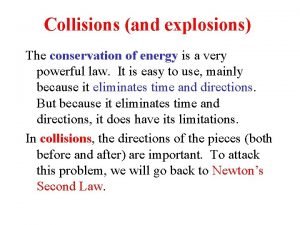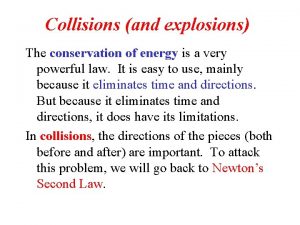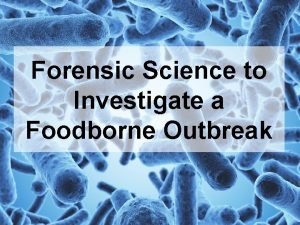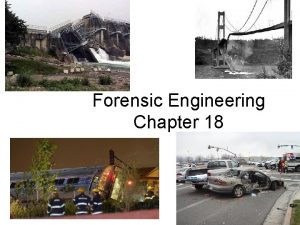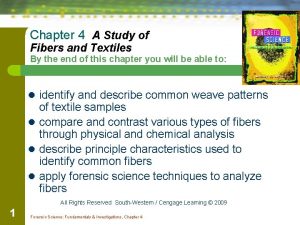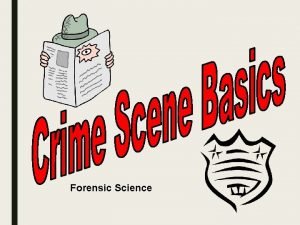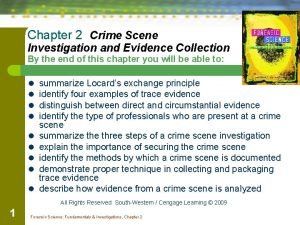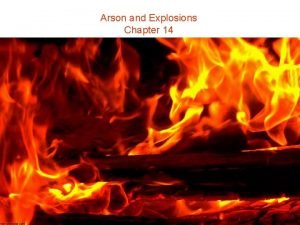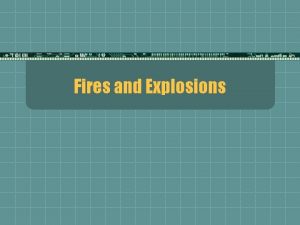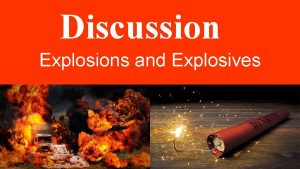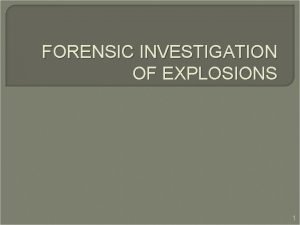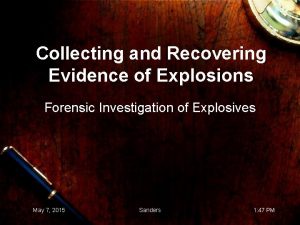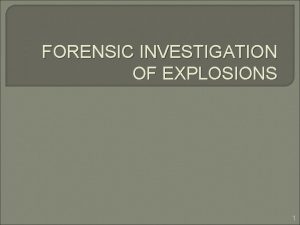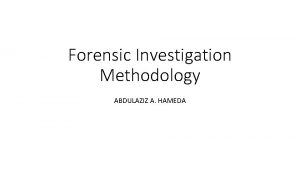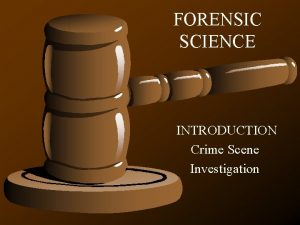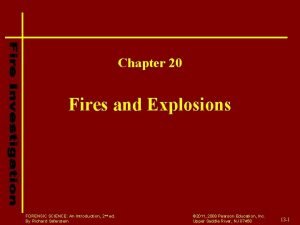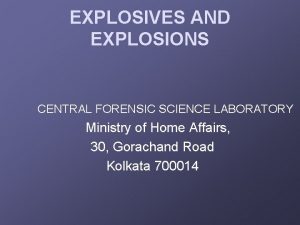CHAPTER 15 FORENSIC INVESTIGATION OF EXPLOSIONS FORENSIC SCIENCE
















- Slides: 16

CHAPTER 15 FORENSIC INVESTIGATION OF EXPLOSIONS FORENSIC SCIENCE: An Introduction by Richard Saferstein

EXPLOSIONS Explosives are substances that undergo a rapid oxidation reaction with the production of large quantities of gases. It is this sudden buildup of gas pressure that constitutes the nature of an explosion. The speed at which explosives decompose permits their classification as high or low explosives. FORENSIC SCIENCE: An Introduction by Richard Saferstein 2

EXPLOSIONS The most widely used explosives in the low-explosive group are black powder and smokeless powder. Black powder is a mixture of potassium or sodium nitrate, charcoal, and sulfur. Smokeless powder consists of nitrated cotton (nitrocellulose) or nitroglycerin and nitrocellulose. FORENSIC SCIENCE: An Introduction by Richard Saferstein 3

EXPLOSIONS Among the high explosives , primary explosives are ultra-sensitive to heat, shock, or friction and provide the major ingredients found in blasting caps or primers used to detonate other explosives. Secondary explosives are relatively insensitive to heat, shock, or friction and will normally burn rather than detonate if ignited in small quantities in the open air. FORENSIC SCIENCE: An Introduction by Richard Saferstein 4

EXPLOSIONS This group comprises the majority of commercial and military blasting, such as dynamite, TNT, PETN, and RDX. FORENSIC SCIENCE: An Introduction by Richard Saferstein 5

HIGH EXPLOSIVES In recent years, nitroglycerin-based dynamite has all but disappeared from the industrial explosive market and has been replaced by ammonium nitrate-based explosives (for example, water gels, emulsions, and ANFO explosives). Secondary explosives must be detonated by a primary explosive. FORENSIC SCIENCE: An Introduction by Richard Saferstein 6

HIGH EXPLOSIVES In many countries outside of the United States, the accessibility of military high explosives to terrorist organizations makes them very common constituents of homemade bombs. RDX is the most popular and powerful of the military explosives, often encountered in the form of pliable plastic known as C-4. FORENSIC SCIENCE: An Introduction by Richard Saferstein 7

HIGH EXPLOSIVES Triacetone triperoxide (TATP) is a homemade explosive that has been used by terrorist organizations. TATP can be made by combining acetone and peroxide in the presence of an acid. Its existence has led to the banning of most liquids on commercial aircraft. FORENSIC SCIENCE: An Introduction by Richard Saferstein 8

COLLECTION AND ANALYSIS The entire bomb site must be systematically searched with great care given to recovering any trace of a detonating mechanism or any other item foreign to the explosion site. Objects located at or near the origin of the explosion must be collected for laboratory examination. FORENSIC SCIENCE: An Introduction by Richard Saferstein 9

COLLECTION AND ANALYSIS Often, a crater is located at the origin and loose soil and other debris must be preserved from its interior for laboratory analysis. One approach for screening objects for the presence of explosive residues in the field or laboratory is the ion mobility spectrometer (IMS). FORENSIC SCIENCE: An Introduction by Richard Saferstein 10

COLLECTION AND ANALYSIS Preliminary identification of an explosive residue using the IMS can be made by noting the time it takes the explosive to move through a tube. A confirmatory test must follow. All materials collected for the examination by the laboratory must be placed in sealed air-tight containers and labeled with all pertinent information. FORENSIC SCIENCE: An Introduction by Richard Saferstein 11

COLLECTION AND ANALYSIS Debris and articles collected from different areas are to be packaged in separate air-tight containers. It has been demonstrated that some explosives can diffuse through plastic and contaminate nearby containers. FORENSIC SCIENCE: An Introduction by Richard Saferstein 12

BACK AT THE LAB Typically, in the laboratory, debris collected at explosion scenes will be examined microscopically for unconsumed explosive particles. Recovered debris may also be thoroughly rinsed with organic solvents and analyzed by testing procedures that include color spot tests, thin-layer chromatography, and gas chromatography-mass spectrometry. FORENSIC SCIENCE: An Introduction by Richard Saferstein 13

BACK AT THE LAB Confirmatory identification tests may be performed on unexploded materials either by infrared spectrophotometry or X-ray diffraction. (1) (2) (3) FORENSIC SCIENCE: An Introduction by Richard Saferstein 14

X-RAY DIFFRACTION X-ray diffraction is applied to the study of solid, crystalline materials. As the X-rays penetrate the crystal, a portion of the beam is reflected by each of the atomic planes. As the reflected beams leave the crystal’s planes, they combine with one another to form a series of light and dark bands known as a diffraction pattern. FORENSIC SCIENCE: An Introduction by Richard Saferstein 15

X-RAY DIFFRACTION Every compound is known to produce its own unique diffraction pattern, thus giving analysts a means for fingerprinting crystalline compounds. FORENSIC SCIENCE: An Introduction by Richard Saferstein 16
 Collisions and explosions
Collisions and explosions Collisions
Collisions Forensic science foodborne outbreak investigation answers
Forensic science foodborne outbreak investigation answers The golden book of camping
The golden book of camping Nibis definition forensics
Nibis definition forensics Forensic anthropology unit
Forensic anthropology unit Analytical skills definition forensics
Analytical skills definition forensics Chapter 6 fingerprints
Chapter 6 fingerprints Until the nineteenth century only plant or animal fibers
Until the nineteenth century only plant or animal fibers Chapter 1 intro to forensic science
Chapter 1 intro to forensic science Forensic criminalist
Forensic criminalist Forensic science chapter 2 vocabulary
Forensic science chapter 2 vocabulary Forensic science chapter 1
Forensic science chapter 1 My favourite subject is music
My favourite subject is music Thomas mocker and thomas stewart
Thomas mocker and thomas stewart Who is this
Who is this The seven s's of crime scene investigation
The seven s's of crime scene investigation
